Pheidole sculptior
| Pheidole sculptior | |
|---|---|

| |
| Scientific classification | |
| Kingdom: | Animalia |
| Phylum: | Arthropoda |
| Class: | Insecta |
| Order: | Hymenoptera |
| Family: | Formicidae |
| Subfamily: | Myrmicinae |
| Tribe: | Attini |
| Genus: | Pheidole |
| Species: | P. sculptior |
| Binomial name | |
| Pheidole sculptior Forel, 1893 | |
| Synonyms | |
| |
On St. Vincent in the early 1890s, the avid collector H. H. Smith (in Forel 1893j) found sculptior to be relatively scarce but very adaptable in habitat. Ranging from sea level to 500 m, it occurred in forests, seashore thickets, and open land. Nests were in loamy soil under pieces of dead wood or stones; one was found in a piece of rotten wood. The colonies were small, in one instance noted by Smith comprising about 200 workers. On Grenada in 1995, Stefan Cover and I found a colony under a rock in a banana plantation at 300 m. On Trinidad, Cover found two other colonies under the bark of rotting logs. A male was present with one of the latter on 19 May, and a winged queen with a Puerto Rico colony collected by J. A. Torres on 26 November. (Wilson 2003)
Identification
See the description in the nomenclature section.
Keys including this Species
Distribution
Recorded by Kempf (1972b) from Puerto Rico, Martinique, St. Vincent, Trinidad, and Venezuela. I have confirmed series from Puerto Rico, St. Vincent, Trinidad, and Suriname. (Wilson 2003)
Latitudinal Distribution Pattern
Latitudinal Range: 18.45° to -9.466667°.
| North Temperate |
North Subtropical |
Tropical | South Subtropical |
South Temperate |
- Source: AntMaps
Distribution based on Regional Taxon Lists
Neotropical Region: Barbados, Colombia, Grenada, Guadeloupe, Netherlands Antilles, Puerto Rico, Suriname, Trinidad and Tobago, Venezuela.
Distribution based on AntMaps
Distribution based on AntWeb specimens
Check data from AntWeb
Countries Occupied
| Number of countries occupied by this species based on AntWiki Regional Taxon Lists. In general, fewer countries occupied indicates a narrower range, while more countries indicates a more widespread species. |

|
Estimated Abundance
| Relative abundance based on number of AntMaps records per species (this species within the purple bar). Fewer records (to the left) indicates a less abundant/encountered species while more records (to the right) indicates more abundant/encountered species. |

|
Biology
Castes
Worker
Minor
Images from AntWeb
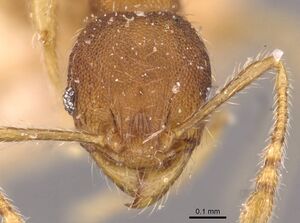   
| |
| Syntype of Pheidole sculptior. Worker. Specimen code casent0908272. Photographer Z. Lieberman, uploaded by California Academy of Sciences. | Owned by MHNG, Geneva, Switzerland. |
 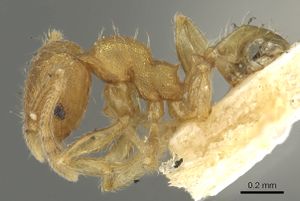 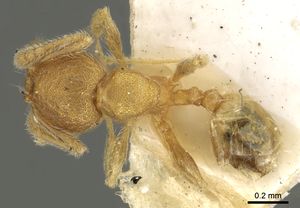 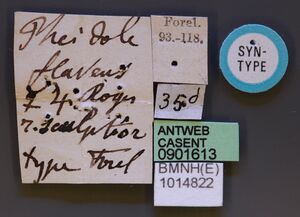
| |
| Syntype of Pheidole flavens sculptior. Worker. Specimen code casent0901613. Photographer Ryan Perry, uploaded by California Academy of Sciences. | Owned by NHMUK, London, UK. |
Major
Images from AntWeb
 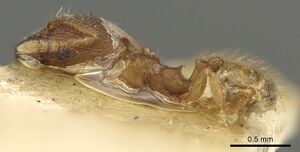  
| |
| Syntype of Pheidole flavens sculptior. Worker (major/soldier). Specimen code casent0901614. Photographer Ryan Perry, uploaded by California Academy of Sciences. | Owned by NHMUK, London, UK. |
Nomenclature
The following information is derived from Barry Bolton's Online Catalogue of the Ants of the World.
- sculptior. Pheidole flavens r. sculptior Forel, 1893g: 414 (s.w.q.) ANTILLES. Raised to species: Wilson, 2003: 506. Senior synonym of tayroni: Longino, 2009: 74.
- tayrona. Pheidole tayrona Wilson, 2003: 518, figs. (s.w.) COLOMBIA. Junior synonym of sculptior: Longino, 2009: 74.
Unless otherwise noted the text for the remainder of this section is reported from the publication that includes the original description.
Description
From Wilson (2003): DIAGNOSIS A member of the “flavens complex” within the larger flavens group, comprising Pheidole asperithorax, Pheidole breviscapa (=Pheidole perpusilla), Pheidole cardiella, Pheidole exigua, Pheidole flavens, Pheidole goeldii, Pheidole moerens, Pheidole mittermeieri, Pheidole nuculiceps, Pheidole pholeops, Pheidole sculptior, Pheidole striaticeps and Pheidole trinitatis differing in the following combination of traits.
Major: carinulae originating on frontal lobes and mesad to frontal carinae travel all the way to the occipital border, turning slightly away from the midline as they progress; shallow antennal scrobes present, their surfaces foveolate and opaque and bearing carinulae inside their anterior half; in dorsal-oblique view, promesonotal dorsal profile is weakly bilobous and descends posteriorly through a gentle gradient to the metanotal groove; pronotal dorsum foveolate and opaque, entirely lacking in carinulae; postpetiolar node trapezoidal viewed from above.
Minor: close to flavens, with carinulae restricted to anterior half of head, and all of head, mesosoma, and side of waist foveolate and opaque.
MEASUREMENTS (mm) Lectotype major: HW 0.78, HL 0.78, SL 0.42, EL 0.10, PW 0.34. Paralectotype minor: HW 0.38, HL 0.42, SL 0.36, EL 0.06, PW 0.24.
COLOR Major: mandibles and most of body light brownish yellow; gaster, antennae, and legs medium yellow.
Minor: concolorous yellow.
Figure. Upper: lectotype, major. Lower: paralectotype, minor. Scale bars = 1 mm.
Type Material
Longino (2009):
Lectotype major worker (here designated, as labeled by Wilson 2003) and associated paralectotype minor worker, queen: Antilles Islands, St. Vincent (H. H. Smith) [lectotype at Museum of Comparative Zoology] (lectotype examined). Wilson, 2003: 506: raised to species.
Pheidole tayrona Holotype major worker and associated paratype minor worker: Colombia, Magdalena, Tayrona Park, Pueblito to S. park boundary, 1977 (C. Kugler) Museum of Comparative Zoology (examined).
Etymology
L sculptior, more engraved, presumably with reference to the more extensive sculpturing of the major head. (Wilson 2003)
References
- Wilson, E. O. 2003. Pheidole in the New World: A dominant, hyperdiverse ant genus. Harvard University Press, Cambridge, MA. (page 506, fig. major, minor described, Raised to species: new status)
- Forel, A. 1893j. Formicides de l'Antille St. Vincent, récoltées par Mons. H. H. Smith. Trans. Entomol. Soc. Lond. 1893: 333-418 (page 414, soldier, worker, queen described)
- Franco, W., Ladino, N., Delabie, J.H.C., Dejean, A., Orivel, J., Fichaux, M., Groc, S., Leponce, M., Feitosa, R.M. 2019. First checklist of the ants (Hymenoptera: Formicidae) of French Guiana. Zootaxa 4674, 509–543 (doi:10.11646/zootaxa.4674.5.2).
- Kempf, W. W. 1972d. A study of some Neotropical ants of genus Pheidole Westwood. I. (Hymenoptera: Formicidae). Stud. Entomol. 15: 449–464.
- Longino, J.T. 2009. Additions to the taxonomy of New World Pheidole. Zootaxa 2181: 1-90. PDF
- Meurgey, F. 2020. Challenging the Wallacean shortfall: A total assessment of insect diversity on Guadeloupe (French West Indies), a checklist and bibliography. Insecta Mundi 786: 1–183.
- Wetterer, J.K. 2021. Ants (Hymenoptera, Formicidae) of St. Vincent, West Indies. Sociobiology 68, e6725 (doi:10.13102/sociobiology.v68i2.6725).
References based on Global Ant Biodiversity Informatics
- Boer P. 2019. Ants of Curacao, species list. Accessed on January 22 2019 at http://www.nlmieren.nl/websitepages/SPECIES%20LIST%20CURACAO.html
- Boer P. 2019. Ants of Saba, species list. Accessed on January 22 2019 at http://www.nlmieren.nl/websitepages/SPECIES%20LIST%20SABA.html
- Delabie J. H. C., R. Céréghino, S. Groc, A. Dejean, M. Gibernau, B. Corbara, and A. Dejean. 2009. Ants as biological indicators of Wayana Amerindian land use in French Guiana. Comptes Rendus Biologies 332(7): 673-684.
- Emery C. 1894. Studi sulle formiche della fauna neotropica. VI-XVI. Bullettino della Società Entomologica Italiana 26: 137-241.
- Fernández, F. and S. Sendoya. 2004. Lista de las hormigas neotropicales. Biota Colombiana Volume 5, Number 1.
- Forel A. 1901. Variétés myrmécologiques. Annales de la Société Entomologique de Belgique 45: 334-382.
- Forel A. 1912. Formicides néotropiques. Part III. 3me sous-famille Myrmicinae (suite). Genres Cremastogaster et Pheidole. Mémoires de la Société Entomologique de Belgique. 19: 211-237.
- Franco W., N. Ladino, J. H. C. Delabie, A. Dejean, J. Orivel, M. Fichaux, S. Groc, M. Leponce, and R. M. Feitosa. 2019. First checklist of the ants (Hymenoptera: Formicidae) of French Guiana. Zootaxa 4674(5): 509-543.
- Galkowski C. 2016. New data on the ants from the Guadeloupe (Hymenoptera, Formicidae). Bull. Soc. Linn. Bordeaux 151, 44(1): 25-36.
- Gregg R. E. 1959. Key to the species of Pheidole (Hymenoptera: Formicidae) in the United States. Journal of the New York Entomological Society 66: 7-48.
- Kempf, W.W. 1972. Catalago abreviado das formigas da regiao Neotropical (Hym. Formicidae) Studia Entomologica 15(1-4).
- Longino J. T. 2009. Additions to the taxonomy of New World Pheidole (Hymenoptera: Formicidae). Zootaxa 2181: 1-90.
- Smith M. R. 1937. The ants of Puerto Rico. Journal of Agriculture of the University of Puerto Rico 20: 819-875.
- Snelling R. R. 2005. Wasps, ants, and bees: aculeate Hymeoptera. Pp. 283-296 in: Lazell, J. 2005. Island. Fact and theory in nature. Berkeley: University of California Press, xx + 382 pp.
- Torres J.A. 1984. Niches and Coexistence of Ant Communities in Puerto Rico: Repeated Patterns. Biotropica 16(4): 284-295.
- Torres, Juan A. and Roy R. Snelling. 1997. Biogeography of Puerto Rican ants: a non-equilibrium case?. Biodiversity and Conservation 6:1103-1121.
- Wheeler W. M. 1905. The ants of the Bahamas, with a list of the known West Indian species. Bulletin of the American Museum of Natural History 21: 79-135.
- Wheeler W. M. 1908. The ants of Porto Rico and the Virgin Islands. Bulletin of the American Museum of Natural History 24: 117-158.
- Wheeler W. M. 1922. The ants of Trinidad. American Museum Novitates 45: 1-16.
- Wilson, E.O. 2003. Pheidole in the New World: A Dominant, Hyperdiverse Genus. Harvard University Press


